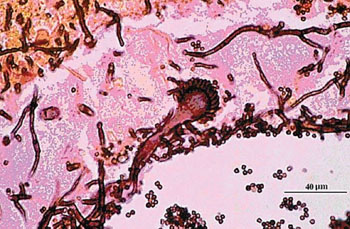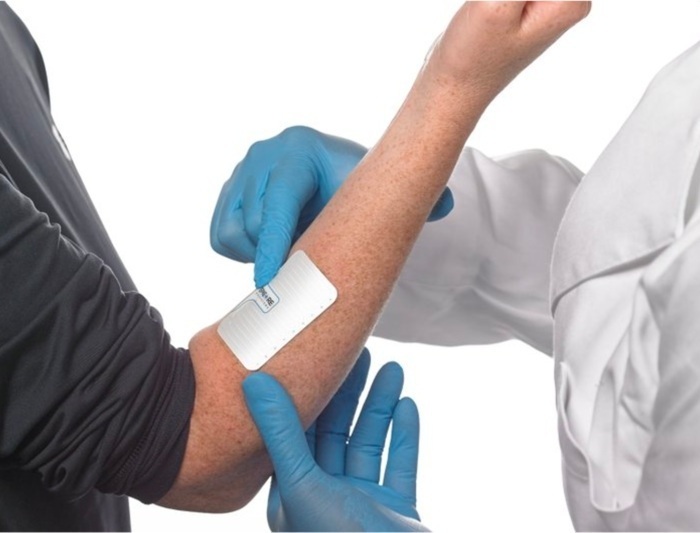Rapid Adaptation of Aspergillus Presents Doctors with Dilemma
|
By LabMedica International staff writers Posted on 14 Oct 2016 |

Image: A histology of Aspergillus fumigatus in lung tissue (Photo courtesy of the CDC).
Aspergillus fumigatus causes a range of diseases in human beings, some of which are characterized by fungal persistence and the fungus can persist by adapting to the human lung environment through physiological and genomic changes.
The physiological changes are based on the large biochemical versatility of the fungus, and the genomic changes are based on the capacity of the fungus to generate genetic diversity by spontaneous mutations or recombination and subsequent selection of the genotypes that are most adapted to the new environment.
Scientists at the Radboud University Medical Center (Nijmegen, Netherlands) and their colleagues suggest that any change can stimulate the fungus to adapt. This applies equally to starting a new treatment, substituting one antifungal medication for another or entirely stopping treatment. Knowing that all environmental changes can stimulate adaptation in the fungus poses a problem for doctors. Treating the fungus with medication could lead to drug resistance, but not treating the fungus or discontinuing the initial treatment makes it easier for the fungus to settle in the lungs. Either one of these options may make it difficult to eradicate the fungus from the patient.
The team explored the adaptation strategies of A. fumigatus in relation to azole resistance selection and the clinical implications thereof for management of diseases caused by Aspergillus spp. The emphasis of the study was what primarily affects lung patients who are long-term carriers of the Aspergillus fungus, such as patients with chronic obstructive pulmonary disease (COPD) or cystic fibrosis. Stress factors, such as triazole exposure, cause mutations that render resistance. The process of reproduction that is sexual, parasexual, or asexual, is probably crucial for the adaptive potential of Aspergillus spp. As any change in the environment can provoke adaptation, switching between triazoles in patients with chronic pulmonary aspergillosis might result in a high-level pan-triazole-resistant phenotype through the accumulation of resistance mutations. These results call for a modification of the current treatment guidelines.
A similar adaptation is expected to occur in response to other stress factors, such as endogenous antimicrobial peptides; over time the fungus will become increasingly adapted to the lung environment, thereby limiting the probability of eradication. The group’s hypothesis challenges current management strategies, and future studies should investigate the genomic dynamics during infection to understand the key factors facilitating adaptation of Aspergillus spp. The study was published on September 13, 2016, in the journal The Lancet Infectious Diseases.
Related Links:
Radboud University Medical Center
The physiological changes are based on the large biochemical versatility of the fungus, and the genomic changes are based on the capacity of the fungus to generate genetic diversity by spontaneous mutations or recombination and subsequent selection of the genotypes that are most adapted to the new environment.
Scientists at the Radboud University Medical Center (Nijmegen, Netherlands) and their colleagues suggest that any change can stimulate the fungus to adapt. This applies equally to starting a new treatment, substituting one antifungal medication for another or entirely stopping treatment. Knowing that all environmental changes can stimulate adaptation in the fungus poses a problem for doctors. Treating the fungus with medication could lead to drug resistance, but not treating the fungus or discontinuing the initial treatment makes it easier for the fungus to settle in the lungs. Either one of these options may make it difficult to eradicate the fungus from the patient.
The team explored the adaptation strategies of A. fumigatus in relation to azole resistance selection and the clinical implications thereof for management of diseases caused by Aspergillus spp. The emphasis of the study was what primarily affects lung patients who are long-term carriers of the Aspergillus fungus, such as patients with chronic obstructive pulmonary disease (COPD) or cystic fibrosis. Stress factors, such as triazole exposure, cause mutations that render resistance. The process of reproduction that is sexual, parasexual, or asexual, is probably crucial for the adaptive potential of Aspergillus spp. As any change in the environment can provoke adaptation, switching between triazoles in patients with chronic pulmonary aspergillosis might result in a high-level pan-triazole-resistant phenotype through the accumulation of resistance mutations. These results call for a modification of the current treatment guidelines.
A similar adaptation is expected to occur in response to other stress factors, such as endogenous antimicrobial peptides; over time the fungus will become increasingly adapted to the lung environment, thereby limiting the probability of eradication. The group’s hypothesis challenges current management strategies, and future studies should investigate the genomic dynamics during infection to understand the key factors facilitating adaptation of Aspergillus spp. The study was published on September 13, 2016, in the journal The Lancet Infectious Diseases.
Related Links:
Radboud University Medical Center
Latest Microbiology News
- Microfluidic Platform Assesses Neutrophil Function in Sepsis Patients
- New Diagnostic Method Confirms Sepsis Infections Earlier
- New Markers Could Predict Risk of Severe Chlamydia Infection
- Portable Spectroscopy Rapidly and Noninvasively Detects Bacterial Species in Vaginal Fluid
- CRISPR-Based Saliva Test Detects Tuberculosis Directly from Sputum
- Urine-Based Assay Diagnoses Common Lung Infection in Immunocompromised People
- Saliva Test Detects Implant-Related Microbial Risks
- New Platform Leverages AI and Quantum Computing to Predict Salmonella Antimicrobial Resistance
- Early Detection of Gut Microbiota Metabolite Linked to Atherosclerosis Could Revolutionize Diagnosis
- Viral Load Tests Can Help Predict Mpox Severity
- Gut Microbiota Analysis Enables Early and Non-Invasive Detection of Gestational Diabetes
- Credit Card-Sized Test Boosts TB Detection in HIV Hotspots
- Fecal Metabolite Profiling Predicts Mortality in Critically Ill Patients
- Portable Molecular POC System Rules Out UTIs in Just 35 Minutes
- POC Lateral Flow Test Detects Deadly Fungal Infection Faster Than Existing Techniques
- Rapid Diagnostic Test Slashes Sepsis Mortality by 39%
Channels
Clinical Chemistry
view channel
Gold Nanoparticles to Improve Accuracy of Ovarian Cancer Diagnosis
Ovarian cancer is considered one of the deadliest cancers, in part because it rarely shows clear symptoms in its early stages, and diagnosis is often complex. Current approaches make it difficult to accurately... Read more
Simultaneous Cell Isolation Technology Improves Cancer Diagnostic Accuracy
Accurate cancer diagnosis remains a challenge, as liquid biopsy techniques often fail to capture the complexity of tumor biology. Traditional systems for isolating circulating tumor cells (CTCs) vary in... Read moreMolecular Diagnostics
view channel
Routine Blood Draws Could Detect Epigenetic Biomarkers for Predicting Cardiovascular Disease Risk
Cardiovascular disease is a leading cause of death worldwide, yet predicting individual risk remains a persistent challenge. Traditional risk factors, while useful, do not fully capture biological changes... Read more
Single Cell RNA Sequencing Could Enable Non-Invasive Blood Disorder Diagnosis
Hematologic disorders are often diagnosed using painful, invasive, and expensive bone marrow aspiration or biopsy procedures. These approaches limit patient compliance and broader utility, leaving a need... Read more
Blood Test Identifies HPV-Associated Head and Neck Cancers 10 Years Before Symptoms
Human papillomavirus (HPV) causes around 70% of head and neck cancers in the United States, and cases are rising each year. Unlike cervical cancers linked to HPV, there is currently no screening test for... Read moreHematology
view channel
Pioneering Model Measures Radiation Exposure in Blood for Precise Cancer Treatments
Scientists have long focused on protecting organs near tumors during radiotherapy, but blood — a vital, circulating tissue — has largely been excluded from dose calculations. Each blood cell passing through... Read more
Platelets Could Improve Early and Minimally Invasive Detection of Cancer
Platelets are widely recognized for their role in blood clotting and scab formation, but they also play a crucial role in immune defense by detecting pathogens and recruiting immune cells.... Read more
Portable and Disposable Device Obtains Platelet-Rich Plasma Without Complex Equipment
Platelet-rich plasma (PRP) plays a crucial role in regenerative medicine due to its ability to accelerate healing and repair tissue. However, obtaining PRP traditionally requires expensive centrifugation... Read moreImmunology
view channel
Companion Diagnostic Test Identifies HER2-Ultralow Breast Cancer and Biliary Tract Cancer Patients
Breast cancer is the most common cancer in Europe, with more than 564,000 new cases and 145,000 deaths annually. Metastatic breast cancer is rising in younger populations and remains the leading cause... Read more
Novel Multiplex Assay Supports Diagnosis of Autoimmune Vasculitis
Autoimmune vasculitis and related conditions are difficult to diagnose quickly and accurately, often requiring multiple tests to confirm the presence of specific autoantibodies. Traditional methods can... Read more
Blood Test Predicts Immunotherapy Efficacy in Triple-Negative Breast Cancer
Triple-negative breast cancer (TNBC) is an aggressive subtype lacking targeted therapies, making immunotherapy a promising yet unpredictable option. Current biomarkers such as PD-L1 expression or tumor... Read more
Simple Genetic Testing Could Predict Treatment Success in Multiple Sclerosis Patients
Multiple sclerosis (MS) patients starting therapy often face a choice between interferon beta and glatiramer acetate, two equally established and well-tolerated first-line treatments. Until now, the decision... Read morePathology
view channelAccurate Pathological Analysis Improves Treatment Outcomes for Adult Fibrosarcoma
Adult fibrosarcoma is a rare and highly aggressive malignancy that develops in connective tissue and often affects the limbs, trunk, or head and neck region. Diagnosis is complex because tumors can mimic... Read more
Clinicopathologic Study Supports Exclusion of Cervical Serous Carcinoma from WHO Classification
High-grade serous carcinoma is a rare diagnosis in cervical biopsies and can be difficult to distinguish from other tumor types. Cervical serous carcinoma is no longer recognized as a primary cervical... Read moreTechnology
view channel
Coral-Inspired Capsule Samples Hidden Bacteria from Small Intestine
The gut microbiome has been linked to conditions ranging from immune disorders to mental health, yet conventional stool tests often fail to capture bacterial populations in the small intestine.... Read more
Rapid Diagnostic Technology Utilizes Breath Samples to Detect Lower Respiratory Tract Infections
Respiratory tract infections (LRTIs) are leading causes of illness and death worldwide, particularly among vulnerable populations such as the elderly, young children, and those with compromised immune systems.... Read moreIndustry
view channel
Werfen and VolitionRx Partner to Advance Diagnostic Testing for Antiphospholipid Syndrome
Antiphospholipid syndrome (APS) is a rare autoimmune disorder that causes the immune system to produce abnormal antibodies, making the blood “stickier” than normal. This condition increases the risk of... Read more




















